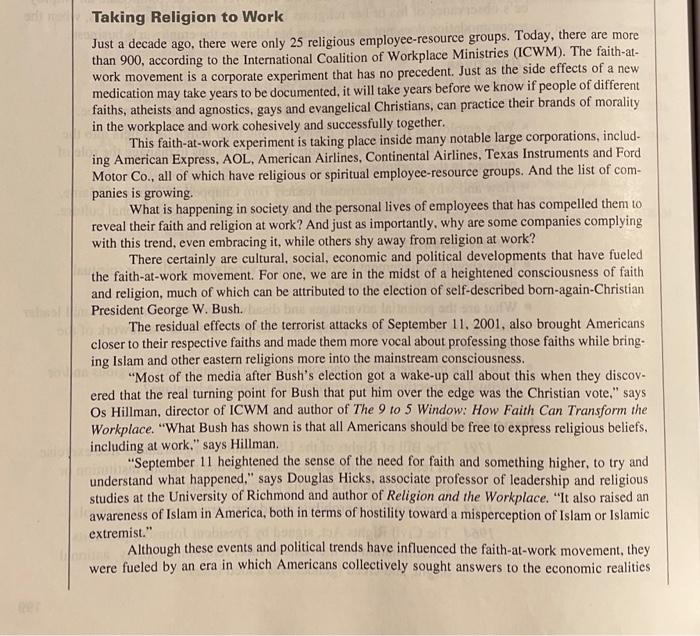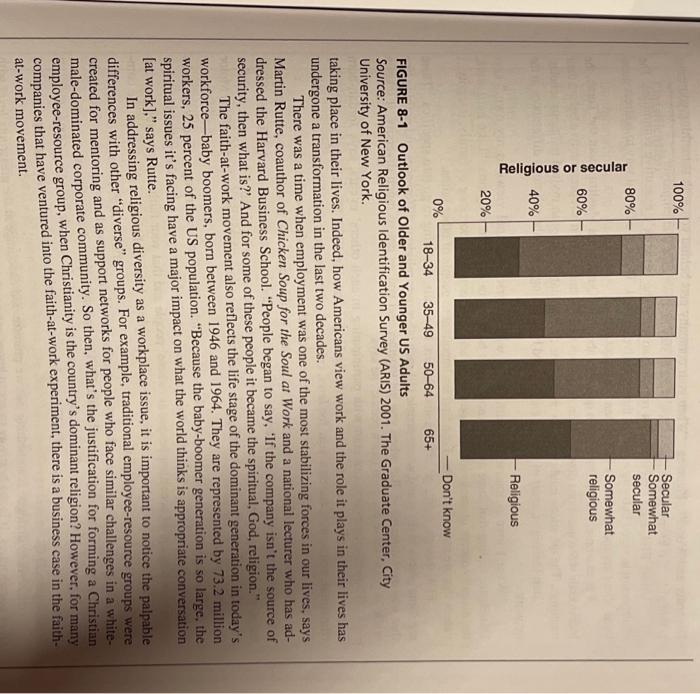Answered step by step
Verified Expert Solution
Question
1 Approved Answer
Take into consideration the movement of Faith at Work (page 200) So are Faith at Work initiatives a good answer, or should we leave our
Take into consideration the movement of "Faith at Work" (page 200) 

So are "Faith at Work" initiatives a good answer, or should we leave our religion and spirituality at the door? Why?
Are Employees Resourcea Groups of Religion and Spirituality different than Race, Gender, Ethnicity, color, etc.?


the 2 pictures ar page 200 in the book
Just a decade ago, there were only 25 religious employee-resource groups. Today, there are more than 900 , according to the International Coalition of Workplace Ministries (ICWM). The faith-atwork movement is a corporate experiment that has no precedent. Just as the side effects of a new medication may take years to be documented, it will take years before we know if people of different faiths, atheists and agnostics, gays and evangelical Christians, can practice their brands of morality in the workplace and work cohesively and successfully together. This faith-at-work experiment is taking place inside many notable large corporations, including American Express, AOL, American Airlines, Continental Airlines, Texas Instruments and Ford Motor Co., all of which have religious or spiritual employee-resource groups. And the list of companies is growing. What is happening in society and the personal lives of employees that has compelled them to reveal their faith and religion at work? And just as importantly, why are some companies complying with this trend, even embracing it, while others shy away from religion at work? There certainly are cultural, social, economic and political developments that have fueled the faith-at-work movement. For one, we are in the midst of a heightened consciousness of faith and religion, much of which can be attributed to the election of self-described born-again-Christian President George W. Bush. The residual effects of the terrorist attacks of September 11, 2001, also brought Americans closer to their respective faiths and made them more vocal about professing those faiths while bring. ing Islam and other eastern religions more into the mainstream consciousness. "Most of the media after Bush's election got a wake-up call about this when they discovered that the real turning point for Bush that put him over the edge was the Christian vote," says Os Hillman, director of ICWM and author of The 9 to 5 Window: How Faith Can Transform the Workplace. "What Bush has shown is that all Americans should be free to express religious beliefs, including at work," says Hillman. "September 11 heightened the sense of the need for faith and something higher, to try and understand what happened," says Douglas Hicks, associate professor of leadership and religious studies at the University of Richmond and author of Religion and the Workplace. "It also raised an awareness of Islam in America, both in terms of hostility toward a misperception of Islam or Islamic extremist." Although these events and political trends have influenced the faith-at-work movement, they were fueled by an era in which Americans collectively sought answers to the economic realities FIGURE 8-1 Outlook of Older and Younger US Adults Source: American Religious Identification Survey (ARIS) 2001. The Graduate Center, City University of New York. taking place in their lives. Indeed, how Americans view work and the role it plays in their lives has undergone a transformation in the last two decades. There was a time when employment was one of the most stabilizing forces in our lives, says Martin Rutte, coauthor of Chicken Soup for the Soul at Work and a national lecturer who has addressed the Harvard Business School. "People began to say, 'If the company isn't the source of security, then what is?' And for some of these people it became the spiritual, God, religion." The faith-at-work movement also reflects the life stage of the dominant generation in today's workforce-baby boomers, born between 1946 and 1964 . They are represented by 73.2 million workers, 25 percent of the US population. "Because the baby-boomer generation is so large, the spiritual issues it's facing have a major impact on what the world thinks is appropriate conversation [at work]," says Rutte. In addressing religious diversity as a workplace issue, it is important to notice the palpable differences with other "diverse" groups. For example, traditional employee-resource groups were created for mentoring and as support networks for people who face similar challenges in a whitemale-dominated corporate community. So then, what's the justification for forming a Christian employee-resource group, when Christianity is the country's dominant religion? However, for many companies that have ventured into the faith-at-work experiment, there is a business case in the faithat-work movement Step by Step Solution
There are 3 Steps involved in it
Step: 1

Get Instant Access to Expert-Tailored Solutions
See step-by-step solutions with expert insights and AI powered tools for academic success
Step: 2

Step: 3

Ace Your Homework with AI
Get the answers you need in no time with our AI-driven, step-by-step assistance
Get Started


